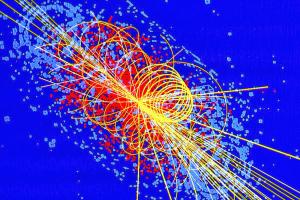Post
Higgs Goes the Theory
7 October 2013
 CERN/Lucas Taylor
CERN/Lucas TaylorRecently in the news there’s been talk of a new cosmological model known as Higgsogenesis. A paper outlining this model has been recently been published Physical Review Letters.1 The term Higgsogenesis refers to the first appearance of Higgs particles in the early universe, just as baryogenesis refers to the appearance of baryons (protons and neutrons) in the early moments after the big bang. While baryogenesis is a fairly well understood process, Higgsogenesis is still very hypothetical.
Experimentally we have observed the Higgs with a mass about 125 times that of the proton. Currently the evidence points to a single Higgs particle, though it will take more experiments to pin down some of the exact properties. This gives theorists an excellent opening. We have shown the particle’s existence and know some of its basic properties, but others properties aren’t set in stone yet, so theorists can play around with different alternatives to see how they might affect cosmology.
In this particular paper, it is proposed that the Higgs has an antiparticle particle they call the anti-Higgs. Regular particles like protons and electrons have antiparticle partners (the antiproton and positron), but with regular particles matter and antimatter appear in equal amounts. This is actually a big mystery in cosmology, because we live in a universe dominated by matter. We aren’t sure how this asymmetry between matter and antimatter came to be in the early universe.
To address this mystery, the authors propose an asymmetry between the Higgs and anti-Higgs. This broken symmetry would then give rise to the dominance of matter in our current universe. They also propose that as the universe cooled, the Higgs particles could decay into dark matter particles, giving rise to dark matter in the universe. If this latter idea is true, then the Higgs should should decay in ways that indicate a dark matter interaction. The theory is an interesting one, but it is very speculative, and that’s important to keep in mind.
Since the Higgs earned the Nobel prize last year we’ve seen a flurry of articles in the popular press about various “revolutionary” theories that connect the Higgs to early cosmology. All of these are still speculative, and will remain so for quite a while. These ideas are exactly what we need. The Higgs will need to be integrated into cosmological theory, and right now we need to explore lots of ideas to see what might work and what doesn’t.
So brace yourselves, the Higgs astrophysics papers are coming.
Servant, Geraldine, and Sean Tulin. “Baryogenesis and dark matter through a Higgs asymmetry.” Physical Review Letters 111.15 (2013): 151601. ↩︎